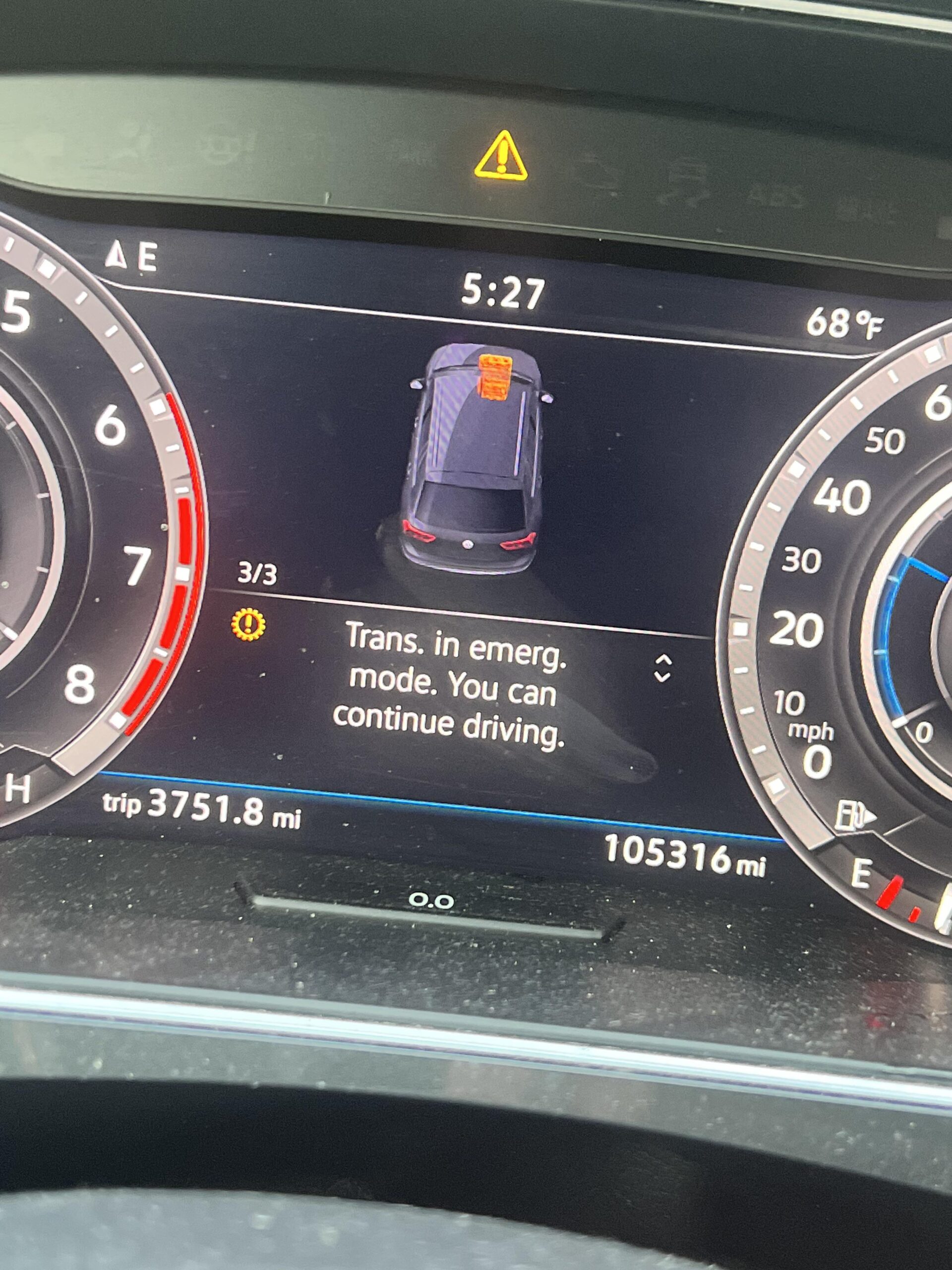If you’re a Tiguan owner, you might have come across the warning message Transmission in Emergency Mode while driving.
This message can be alarming and confusing, especially if you don’t know what it means.
In this article, we’ll explain what Trans in Emergency Mode means and what you should do when you see this message.
We’ll also discuss some common causes of this issue and how to fix it.
Stay tuned to learn more about this topic!
What Does Trans in Emergency Mode Mean?
Trans in Emergency Mode is a warning message that can appear on your Volkswagen Tiguan’s dashboard while driving. This message indicates that your car’s electronic systems have detected a fault or missing input that is required for proper operation.
When this self-defense system is activated, it will protect the power plant and signal drivers to go for a service advisor. The system will take urgent measures for further protection, and in serious cases, it will automatically turn into an emergency operation.
Depending on the make and model, the indicator is displayed differently, such as Check Engine, S, Hold, OD OFF, Check AT, etc. Sometimes, you even know your car has issues before the signal is on due to the following symptoms: You may experience lots of jerks while changing gears, you can only start.
What Are The Reasons For Trans In Emergency Mode Tiguan?
When your Volkswagen Tiguan displays the warning message Transmission in Emergency Mode, it means that your car’s electronic systems have detected a fault or missing input that is required for proper operation. The system will take urgent measures for further protection, and in serious cases, it will automatically turn into an emergency operation.
1: Improper amount of transmission fluid
An abnormal level of fluid can lead to improper operation of the gearbox. This can happen due to a leak in the system, or the fluid level is too low or too high. If the fluid level is too low, it can cause the transmission to overheat and fail. If the fluid level is too high, it can cause the fluid to foam, which can lead to erratic shifting and slipping of the gears.
2: Hydraulic malfunction
The hydraulic system is responsible for controlling the transmission’s shifting. A malfunction in this system can cause the transmission to enter emergency mode. This can happen due to a faulty solenoid, a clogged valve body, or a damaged pump. If the hydraulic system is not working correctly, it can cause the transmission to slip, shift erratically, or not shift at all.
3: Electronic system issues
Modern automatic transmissions consist of complex mechanisms built from multiple parts and assemblies. Sometimes, a failure is a common issue that can cause transmission in emergency mode. This can happen due to a faulty sensor, a damaged wiring harness, or a malfunctioning control module. If the electronic system is not working correctly, it can cause the transmission to shift erratically, slip, or not shift at all.
4: Abrasion of the valve body channels
The valve body channels are responsible for directing hydraulic fluid to the appropriate clutch pack or band servo. Abrasion of these channels can cause the transmission to enter emergency mode. This can happen due to wear and tear, debris in the fluid, or a damaged valve body. If the valve body channels are not working correctly, it can cause the transmission to slip, shift erratically, or not shift at all.
Also Read: P0442 VW Jetta: All You Need To Know About This Error Code
Can continue driving VW Golf transmission in emergency mode?

If you’re facing the issue of Transmission in Emergency Mode in your Volkswagen Golf, it’s natural to wonder if you can continue driving your car. If your VW transmission is in emergency mode, you can continue driving, yet it means you need to pay for costly repairs.
However, it’s important to note that the transmission will experience contamination due to debris and more serious damage. In this case, the mechanism will get hotter and create extra loads on the engine. Therefore, it’s highly recommended to visit a service advisor to identify the mechanical failure and eliminate it before it turns into a more serious breakdown costing more investment to fix.
The service advisor will diagnose the problem and provide you with the best solution to fix it. Depending on the cause of the issue, the solution may involve replacing a faulty sensor, repairing a damaged wiring harness, or replacing a damaged valve body. It’s important to address the problem as soon as possible to avoid further damage to your vehicle.
What is the transmission option available on the Volkswagen Tiguan?
The Volkswagen Tiguan is a compact SUV that has been in production since 2007. It is available in both petrol and diesel engine options. The transmission option available on the Volkswagen Tiguan is an automatic transmission.
The Volkswagen Tiguan 2017-2020 is available in Diesel Option with Automatic transmission. The transmission is a Direct Shift Gearbox (DSG) that provides smooth and quick gear changes.
The DSG transmission is a dual-clutch transmission that uses two clutches to shift gears. One clutch controls the odd gears, while the other clutch controls the even gears. This allows for faster gear changes and smoother acceleration.
The DSG transmission is a popular choice among Volkswagen Tiguan owners because of its reliability and performance. It is also more fuel-efficient than a traditional automatic transmission. The DSG transmission is designed to provide a sporty driving experience, with quick and precise gear changes. It is also equipped with a manual mode that allows the driver to shift gears manually using paddle shifters on the steering wheel.
The DSG transmission is a complex system that requires regular maintenance to ensure optimal performance. It is recommended to have the transmission fluid changed every 40,000 miles to prevent damage to the transmission.
The transmission fluid is responsible for lubricating the gears and keeping the transmission cool. Over time, the fluid can become contaminated with debris and lose its effectiveness. Regular maintenance can help prevent costly repairs and extend the life of the transmission.
What is the code P173500 on a DSG fault?
The code P173500 on a DSG fault is a position sensor for clutch 1 electrical malfunction. This fault code indicates that there is a problem with the clutch position sensor in the DSG transmission.
The clutch position sensor is responsible for monitoring the position of the clutch and sending signals to the transmission control module (TCM) to ensure that the clutch is engaging and disengaging properly.
There are several reasons why the clutch position sensor may malfunction. One common cause is a faulty sensor. Over time, the sensor can become damaged or worn out, which can cause it to malfunction. Another common cause is a wiring issue.
If the wiring to the sensor is damaged or corroded, it can cause the sensor to malfunction. In some cases, the problem may be with the TCM itself. If the TCM is not receiving the correct signals from the clutch position sensor, it can cause the transmission to enter emergency mode.
If you’re facing the issue of P173500 on a DSG fault, it’s important to have the problem diagnosed by a qualified mechanic. The mechanic will use a diagnostic tool to read the fault codes stored in the TCM and determine the cause of the problem.
Depending on the cause of the problem, the solution may involve replacing the clutch position sensor, repairing the wiring, or replacing the TCM.
How do I identify a VW DSG transmission?
If you’re wondering how to identify a VW DSG transmission, there are several ways to do so. One way is to look at the gear stick and see if there is an embossed “DSG” logo.
This logo indicates that the car is equipped with a DSG transmission. Another way to identify a DSG transmission is to check your car’s manual. The manual will provide details about your gearbox, and it will likely be listed as having DSG when you purchase it.
Another way to identify a DSG transmission is to observe the shifting pattern. DSG transmissions are known for their quick and precise gear changes. They are designed to provide a sporty driving experience, with smooth acceleration and fast gear changes.
If you notice that your car is shifting gears quickly and smoothly, it may be equipped with a DSG transmission.
It’s important to note that DSG transmissions are complex systems that require regular maintenance to ensure optimal performance. It’s recommended to have the transmission fluid changed every 40,000 miles to prevent damage to the transmission.
The transmission fluid is responsible for lubricating the gears and keeping the transmission cool. Over time, the fluid can become contaminated with debris and lose its effectiveness. Regular maintenance can help prevent costly repairs and extend the life of the transmission.
FAQs
What is a DSG transmission, and how does it work?
A DSG transmission is a dual-clutch automatic transmission that combines the best attributes and efficiency of a standard manual transmission and the ease of use of a more traditional automatic. It can be operated in a fully automatic mode or a semi-automatic mode, where the driver uses either the gearshift shift lever or steering wheel-mounted paddles to select the desired gear.
What is the difference between Volkswagen DSG, Porsche PDK, Audi S Tronic, and BMW DCT?
All of these transmissions are dual-clutch automatic transmissions that use two clutches to shift gears. The main difference is in the way they are designed and the manufacturer-specific software that controls them.
What are the common problems of the DSG transmission?
Common problems of the DSG transmission include shaking and shuddering, gear slippage, transmission overheating, grinding noises, and mechatronic failure.
What are the common maintenance tasks for DSG transmissions?
Common maintenance tasks for DSG transmissions include changing the transmission fluid and filter every 40,000 miles, checking the transmission oil level, and inspecting the transmission for leaks.
What is the service interval for DSG transmissions?
The service interval for DSG transmissions is 40,000 miles.
What are the VW/Audi models and years that can be equipped with a DSG transmission?
Most VW/Audi models from 2003 to present can be equipped with a DSG transmission.
What is the DSG transmission oil service information?
The DSG transmission oil service information includes the type of oil to use, the amount of oil needed, and the procedure for changing the oil.
What are the torque specs for the DSG transmission?
The torque specs for the DSG transmission include the torque specifications for the flywheel bolts, the pressure plate bolts, and the transmission-to-engine bolts.
What are the performance upgrades available for DSG transmissions?
Performance upgrades for DSG transmissions include software upgrades, clutch upgrades, and transmission cooler upgrades.
What is the reliability of the DSG transmission?
The DSG transmission is generally considered to be reliable, but it requires regular maintenance to ensure optimal performance and prevent costly repairs.
Conclusion
The Volkswagen Tiguan is a compact SUV that is available with an automatic transmission option.
The DSG transmission is a popular choice among Volkswagen Tiguan owners because of its reliability, performance, and fuel efficiency.
Regular maintenance is required to ensure optimal performance and prevent costly repairs.
If you’re experiencing any issues with your DSG transmission, it’s important to have it diagnosed and repaired by a qualified mechanic.
The DSG transmission is a complex system that requires regular maintenance to ensure optimal performance.
If you’re considering purchasing a Volkswagen with a DSG transmission, it’s important to understand how to identify it and how to maintain it properly.




